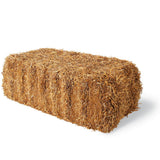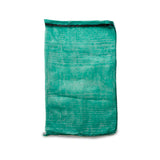Barley Straw Bales
BARLEY IS IN STOCK AND READY TO SHIP!
Barley Straw is Nature's cure for a chemical-free Algae solution.
Barley Straw does not kill algae, although; it has been proven to prevent and slow Algae growth without affecting plants, fish, frogs, snails, turtles, humans, pets or wildlife of any kind.
Barley is a natural and ecologically friendly Algae preventative treatment that has been proven to be very effective. Studies have shown that the barley straw’s high lignin content provides a food source for beneficial bacteria that functions by blocking the growth of Algae cells. It is important to note that Barley Straw does not kill algae or any other form of aquatic growth, it merely blocks the growth of Algae cells.
When is the best time to start using barley straw? Barley Straw works best when applied in a water body before the Algae starts to bloom/grow. What is the second best time to put barley straw in my pond? When you really need it. If the color of the water is pea green and/or green scummy pieces are floating on the top, applying barley will help to clear it up. However, It will take longer to work if there is an ongoing algae problem already present. In some cases, when algae blooms are prevalent, the existing Algae will have to be reduced with either an Algaecide product or be reduced on its own.
Why should I use barley straw for Algae control? Barley straw is non-toxic, inexpensive, long lasting, low maintenance, has beneficial effects, and best of all, it works. Barley Straw carries no use restrictions and is completely safe for use in water.
- Our Barley bales are sourced locally, from an organic farm that produces the Barley grain for livestock feed and for the beverage industry. Our Barley is clean, Organic and selected specifically for use in ponds and lakes.
- Our bales are full size, approximately 34 - 36 inches long, 20 inches wide by 15 inches tall.
- Bales are made using farming implements so there may be some variance in size, but we do our best to work with our local grower to ensure consistency in the quality of the product.
Approximate weight: 30 - 40 pounds per bale
Technical Specifications
| Size Pond | Barley Straw Bales Only | Bales with Bags |
| 1/4 Acre Pond | 1 bale | 1 bale with 6 large mesh bags |
| 1/3 Acre Pond | 2 bales | 2 bales with 12 large mesh bags |
| 1/2 Acre Pond | 3 bales | 3 bales with 18 large mesh bags |
| 1 Acre Pond | 6 bales | 6 bales with 36 large mesh bags |
Fill bags with straw from opened bales and place the bags around the pond's edge.
Stake, tether or anchor the bags or bale in shallow areas of your lake or pond with half of the bag or bale under water and half of the bag or bale above water. Place around the perimeter of the pond or along lake frontage. For best results, place bags or bales near water movement such as aerators, waterfalls, springs, or inflowing water. This will assist in dispersing byproduct of Barley throughout the entire pond or target treatment area. Aerated Ponds may use less barley than the recommended application rate.
Leave Barley Straw in the pond until either the bale or filled bags have decreased in volume by approximately 30%, or as a general rule replace bales or filled bags every 6 months.
Start early in the Spring, late March to early April and replace in the Fall so the effects will last all winter long, creating a cleaner, algae free pond the following Spring.
*Bales and bags will float initially but will sink with time if not weighted or staked into place.
How to use Barley Straw:
| Size Pond | Barley Straw Bales Only | Bales-n-Bag Kit |
| 1/4 Acre Pond | 1 bale | 1 bale with 6 large mesh bags |
| 1/3 Acre Pond | 2 bales | 2 bales with 12 large mesh bags |
| 1/2 Acre Pond | 3 bales | 3 bales with 18 large mesh bags |
| 1 Acre Pond | 6 bales | 6 bales with 36 large mesh bags |
Fill bags with straw from opened bales and place the bags around the pond's edge.
Stake, tether or anchor the bags or bale in shallow areas of your lake or pond with half of the bag or bale under water and half of the bag or bale above water. Place around the perimeter of the pond or along lake frontage. For best results, place bags or bales near water movement such as aerators, waterfalls, springs, or inflowing water. This will assist in dispersing byproduct of Barley throughout the entire pond or target treatment area. Aerated Ponds may use less barley than the recommended application rate.
Leave Barley Straw in the pond until either the bale or filled bags have decreased in volume by approximately 30%, or as a general rule replace bales or filled bags every 6 months.
Start early in the Spring, late March to early April and replace in the Fall so the effects will last all winter long, creating a cleaner, algae free pond the following Spring.
*Bales and bags will float initially but will sink with time if not weighted or staked into place.





